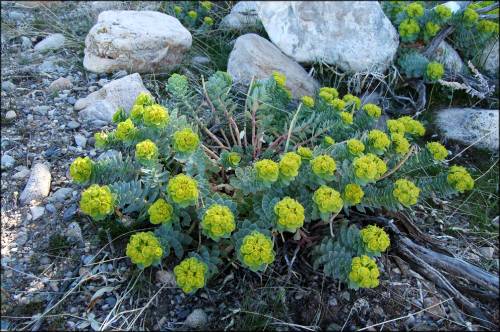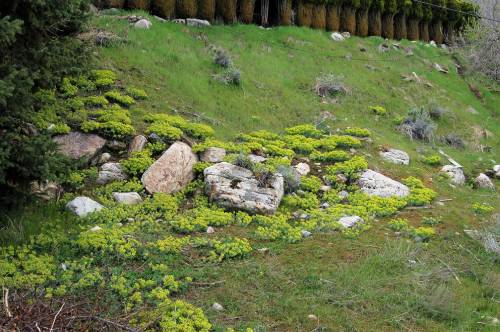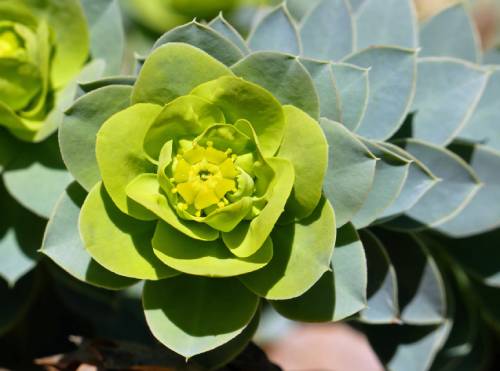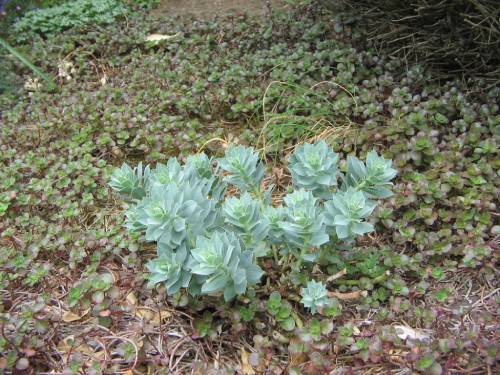Myrtle spurge identification and control
Information about the noxious weed myrtle spurge. Myrtle spurge is also known by its scientific name, Euphorbia myrsinites.
About this weed
Myrtle spurge is a non-regulated Class B noxious weed in King County. This means property owners are not required to control this species on their property, though it is encouraged. It is also on the Washington quarantine list.
Myrtle spurge is known as Euphorbia myrsinites and it is in the spurge family. Other common names include donkey-tail spurge and creeping spurge.

Why it's a problem
Myrtle spurge has escaped cultivation in other counties in Washington state. It is a hardy, drought-tolerant plant that does well in poor soils. These qualities make it a successful competitor with native species.
Myrtle spurge is also a human health concern due to its caustic latex sap. It causes nausea, vomiting, and diarrhea when digested. Skin contact with the sap causes redness, swelling, and blisters. The sap can also cause blindness if it gets into the eyes.
Plant description
Myrtle spurge is a perennial (2+ year life cycle), herbaceous (not woody) plant. Mature plants are 4 to 6 inches tall and spread up to 18 inches wide. Leaves, stems, and roots all exude a milky, caustic sap when broken.
Fleshy, blue-green leaves form tight spirals around outward growing/leaning stems. The leaves become grayer in drought. Stems branch out from a central carrot-like taproot.
Flowers appear as neon green spiral clusters at stem tips. Central flowers are not obvious, neon green leaf-like petals (bracts) spiral around the flower before leaves.
The small seeds can be projected from the plant up to 15 feet and can survive in the soil for around 8 years. Root fragments can also produce new plants.
Myrtle spurge is native to the Mediterranean region and was introduced to the US as an ornamental. It prefers dry, well-drained soils in full sun. It is popular for rock gardens and low-water landscaping.



Be aware of look-alike plants
The flowers and bracts look similar to other spurges. However, the succulent leaves of myrtle spurge are unique. Dalmatian toadflax another noxious weed, can resemble myrtle spurge when the stems are young. Dalmatian toadflax is upright with flowers that resemble snapdragons.
When in doubt, take photos and report them on iNaturalist.
What to do if you find it
Because myrtle spurge is not known to escape cultivation in King County, property owners are not required to control it. We can provide advice on how to safely control myrtle spurge, but there is generally no legal requirement to do so. The King County Noxious Weed Control Board encourages property owners to remove myrtle spurge where possible, and to avoid introducing it to new landscapes.
Control methods
We recommend using a combination of methods to control noxious weeds. In areas with few weeds, it is important to act quickly before they become harder to control. Make a long-term plan as it often takes several years to get rid of most weeds. Start in the least infested areas first and then move into more heavily infested areas.
Any control program must be long term due to the soil seed bank. When controlling myrtle spurge, it is important to protect yourself from the sap. Wear long sleeves, gloves, shoes, and eye protection. If sap contacts skin, make sure to wash the area.
Manual/mechanical control
Small infestations can be dug or pulled. Pull plants early in the season before seed formation. Remove as much of the root as possible. Monitor for regrowth. Mowing is ineffective and not recommended.
Cultural control
Keep desirable vegetation healthy and thick to prevent myrtle spurge from spreading. Do not disturb the plants during seed set to minimize seed dispersal. Survey regularly for new populations and remove promptly.
Regular cultivation is effective for controlling myrtle spurge in fields. It does not spread as well amongst competitive grasses.
Herbicide control
Stay safe when using herbicide:
- Always read the label before use.
- Wear a long-sleeved shirt, long pants, shoes, and eye protection.
- Follow state and local regulations.
The best time to treat is in the late fall. 2,4D, dicamba, and glyphosate have all provided adequate control. Due to myrtle spurge’s waxy leaf surface, use a surfactant when spraying with herbicide.
Please refer to the PNW Weed Management Handbook for the most up to date and specific method for chemical control of myrtle spurge.
For more information or a site-specific recommendation in King County, contact the noxious weed program. For information in other locations, contact your local weed board or extension office.
Disposal instructions
Bag entire plant and dispose in the garbage. Composting at home or with municipal yard waste is not recommended.
Noxious Weed Disposal - Washington State Noxious Weed Control Board

 Translate
Translate